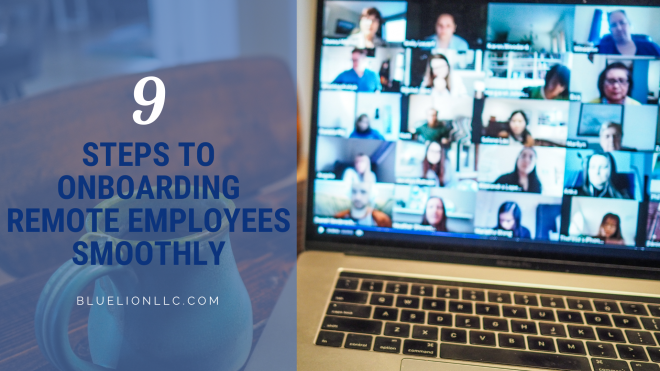
Like most organizations, your company has probably gotten into somewhat of a rhythm when it comes to remote work since the start of the COVID-19 pandemic. You have had several months to figure out new systems and technology as everyone learns how to work as a team and remain productive from home. But have you gone through the process of hiring and onboarding remote employees yet?
If you don’t have experience with virtual onboarding but are ready to start growing your remote team, remember that the process still has the same goals as onboarding new employees in person. The main difference is that you will need to put some extra effort and creativity into ensuring your new telecommuting hires are engaged.
Here are a few tips to keep in mind as you integrate new team members into your virtual work environment:
- Focus on creating more face-to-face interactions. Use video and other methods and activities to make them feel seen and involved.
- Take it slow. Times are already stressful and challenging, so trying to squeeze too much information at a time can be overwhelming.
- Adjust your onboarding materials and content for remote situations and digital platforms. Use online and other digital tools to make the process more efficient.
We have also put together a list of nine steps for onboarding remote employees to help you cover all your bases. Read on and then modify your process accordingly!
9 Steps for Onboarding Remote Employees
These nine steps for virtual onboarding largely require planning and preparing ahead of time so you’re ready when new team members start. Keep in mind that one of the most important keys to success when managing a remote workforce is maintaining employee interaction and engagement!
1. Provide information, materials, and equipment ahead of time.
We’re talking everything from new hire forms to their equipment and welcome kit!
New Employee Paperwork
Do you normally work in all paper? It’s probably time to convert new employee paperwork into a digital format to eliminate the headache of physical paper copies. You could use an e-signature tool, like a secure PDF or a secure site like DocuSign. This includes orientation items like tax documents, contracts and agreements, and any other standard paperwork for your company or the specific role.
First Day Welcome Email
Email new hires a welcome message with what to expect for their first day, such as:
- Agenda for their first day and week
- Links and details for relevant meetings
- Early access to employee portal or intranet
- Materials they may need for initial projects or assignments
Equipment & Technology
In order for virtual onboarding to be successful, new remote employees first need the right technology. Send their computer, mouse, keyboard, phone, and all other technology and equipment they may require for their role. Coordinate with your IT department to make sure any necessary software is installed.
Include setup instructions to help them get everything up and running as quickly and easily as possible. Your IT is probably already very busy, so consider collaborating with them to create standard tutorials and guides (even videos). Adding these materials to your onboarding program can make the process smoother and more efficient for everyone.
Welcome Kit
Send a welcome kit to new hires to help them feel like part of the team. In addition to essential items like the employee handbook and benefits information, deck them out with some company swag (e.g.: notebook, pens, shirt, hoodie, jacket, bag, water bottle, etc.). Consider adding a welcome gift like a gift card to their local coffee or lunch spot.
2. Create an onboarding plan and schedule.
Start with the new employee’s first week: What will you have them learn and work on first? Make a schedule that includes time for breaks and regular check-in meetings. Consider what other meetings or events you’d like them to attend to help them learn and get caught up on relevant projects.
You should also have a coaching plan in place that includes regular meetings or other ways to build relationships with their direct manager and the rest of their team. Perhaps the new hire could spend a certain amount of time working alongside each team member.
Set milestones and ways to check in on how they’re doing, what their learning, and how they’re progressing. Managers should use one-on-one meetings to further explore the new employee’s job expectations and goals, as well as the company and team culture.
3. Assign a mentor.
Pair each new telecommuting team member with a mentor. This means someone other than their direct supervisor who can meet with them regularly via video conference and check in frequently with helpful and friendly chats.
An onboarding buddy can guide new staff through the initial weeks or months to show them the ropes, connect them to the right people, and help them be productive sooner. It also helps them to build relationships and get to know their colleagues and peers in what can otherwise be a lonely work environment.
4. Welcome and introduce them to the team.
Send an announcement to your current team informing them who the employee is, what their role is, and what they bring to the company. Be sure to copy the new employee on the email. If yours is more of a Slack team, introduce the employee in a #general channel instead.
Keep it social while onboarding remote employees by hosting a meet-the-team video session. Have everyone introduce themselves with their role and a fun personal fact. You could even make this event a fun virtual happy hour to create a more casual setting.
Additionally, scheduling brief individual meetings or small group chats between the new hire and coworkers will help them continue to get to know one another.
5. Get them online and connected.
Since technology is vital for work-from-home teams, it’s a good idea to schedule an IT orientation as the first event of a new remote employee’s first day. The IT department can ensure their computer and equipment is set up properly and that all software and accounts are accessible.
IT should connect them on any necessary communication channels right away, including calendar invites, pre-scheduled meetings, email groups, and messaging tools (e.g.: Slack). Give them a virtual walkthrough of these tools and workspaces, including all logins, VPN, and project management tools (e.g.: Asana or Trello).
6. Schedule a company orientation.
Remember, new employee orientation is different from the onboarding process. Orientation should occur on the first day or within the first week, depending on how much you have to cover.
Orientation is a one-time event covering:
- Organization’s culture, mission, vision, and values
- Paperwork and routine tasks
- Benefit plans
- Review of safety, health, and other key policies
- Review of administrative procedures (i.e., who to go to for certain needs)
- Interdepartmental relationships
New employee orientation often involves presentations from other department heads, human resources, the hiring manager, the new hire’s mentor, and other relevant team members. Are you onboarding several remote employees at once? Give the orientation to the whole group!
Going virtual may require adjustments to your orientation, too. LinkedIn learning partner Kelly Chuck explained that the company expanded its one-day onboarding program into a five-day program when it went remote back in March. “We didn’t want to transition everything into a full day virtually because we weren’t sure how new hires would respond after home life for so many people has changed so much,” Chuck told the Society for Human Resource Management (SHRM). “We felt we could best do that with shorter bursts spread over a week to allow flexibility with working from home, and then we could adapt as needed.”
This approach of spreading out the orientation can help ensure new employees aren’t overwhelmed. Focus on one thing each day, from company culture, mission, vision, and values on one day to specific department presentations on the next.
7. Train the new hire on their job responsibilities and expectations.
Set clear and realistic expectations immediately when onboarding remote employees.
But shouldn’t they already have an understanding of their job responsibilities?
Sure, they know what you discussed in the interviews and agreement. But it’s time to start diving deeper into the guidelines and expectations for their new position.
A 2019 Indeed survey found that 44% of new hires who left within the first six months said receiving clear guidelines about what their responsibilities were could have helped them stay longer.
There is no better way to learn than by doing, so coordinate virtual shadowing and training sessions between the new employee and their colleagues. This can include other departments and teams to give the newcomer a comprehensive picture of everyone’s roles and responsibilities and an understanding of how their own position fits in.
Give a specific list of tasks and/or assignments to complete after training and advise them on the points of contact for certain needs. Work together with the new employee to create goals for their first 30, 60, and 90 days on the job.
8. Focus on engagement.
While remote work sounds cushy, it can pose challenges when it comes to employee interaction and engagement. It’s important that managers combat this by taking extra measures to make new remote workers feel included and valued.
Three ways to engage remote employees include:
- Frequent 1:1 meetings with the manager: Schedule regular check-ins with your new remote staff often, at least until they have gotten in a groove and are comfortable with their assignments and responsibilities. You might have brief one-to-ones at the end of each day to see how they’re doing, give them feedback, and make sure they’re on the right track. Eventually, you might reduce these meetings down to a weekly basis.
- Interactive onboarding: People learn by doing—in fact, research shows that interactive activities are six times more likely than videos or text to help us learn and retain information. Spice up your virtual onboarding experience with games, polls, mini-quizzes, Zoom breakout rooms, and ice breakers to help drive the information home.
- Spontaneous interactions: Since remote work doesn’t allow for the casual interactions that occur during moments like grabbing coffee or passing by a coworker’s office, we miss out on those opportunities to build connections. Get creative and find ways to spark random, enjoyable conversations between new hires and the rest of the team. Slack users often create a #random channel, where they pose fun questions and topics.
9. Gather feedback about your virtual onboarding.
As your business navigates the process of onboarding remote employees, be sure to get their take, too. Survey new team members one week out and again at 45 days by asking them how helpful they found the program, which areas they feel worked, and where they might be room for improvement.
Gathering this feedback will give you ideas on how to keep improving the process for future employees. Plus, it makes employees feel valued and heard, further increasing retention rates.
Virtual Onboarding Made Easy
When you plan and prepare for onboarding remote employees ahead of time, it doesn’t have to be a lot of extra work or stress. While it does call for some more consideration regarding employee engagement, the bit of extra effort is well worth it. A comprehensive onboarding program is vital to solidifying a new team member’s decision to stay and heavily influences their success in their new role.
Do you need help to create a virtual onboarding plan for your business’s unique needs? Contact BlueLion at 603-818-4131 or info@bluelionllc.com to learn more about our HR consulting services today! We have significant experience helping employers streamline their hiring processes.
The information on this website, including its newsletters, is not, nor is it intended to be legal advice. You should contact an attorney or HR specialist for advice on your individual situation.


